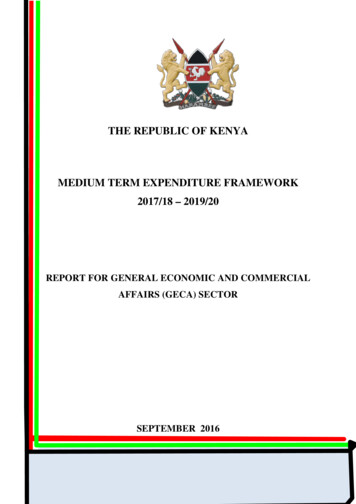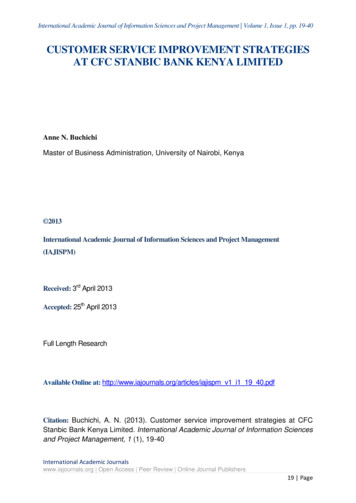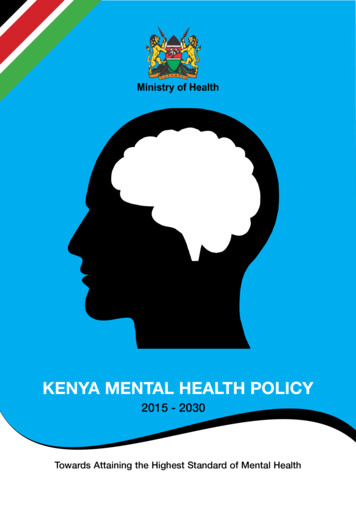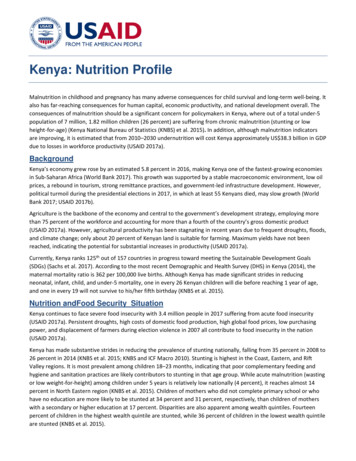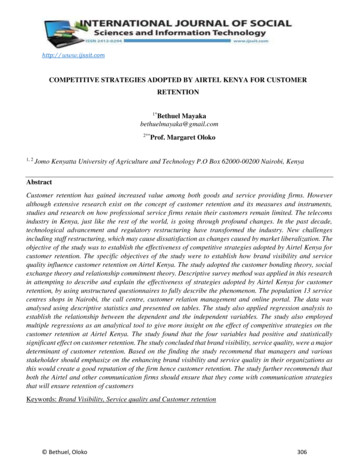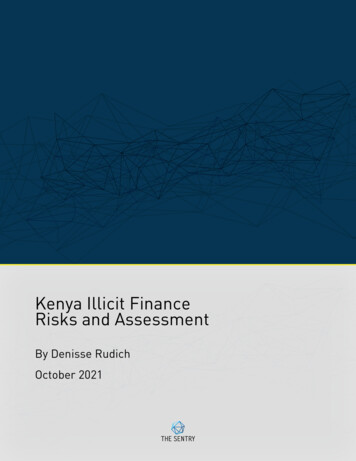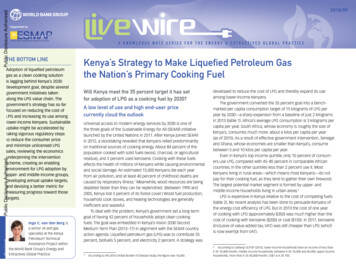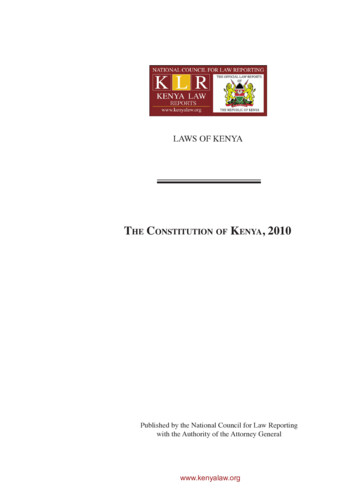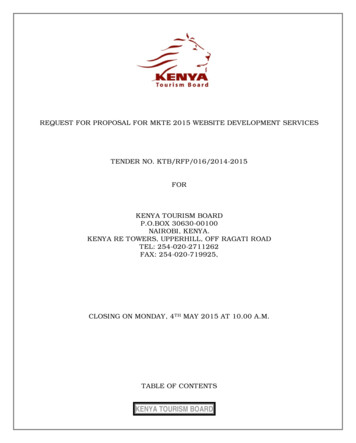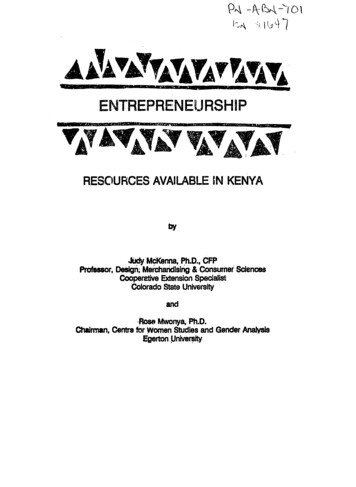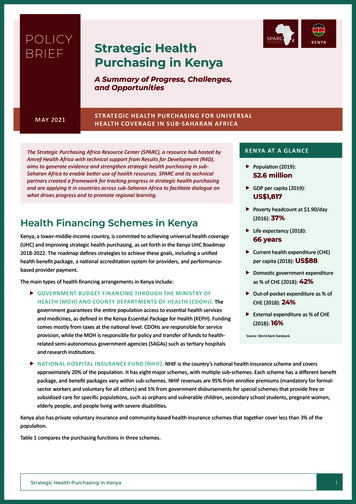
Transcription
POLICYBRIEFKENYAStrategic HealthPurchasing in KenyaA Summary of Progress, Challenges,and OpportunitiesMAY 2021STRATEGIC HEALTH PURCHASING FOR UNIVERSALHEALTH COVERAGE IN SUB-SAHARAN AFRICAThe Strategic Purchasing Africa Resource Center (SPARC), a resource hub hosted byAmref Health Africa with technical support from Results for Development (R4D),aims to generate evidence and strengthen strategic health purchasing in subSaharan Africa to enable better use of health resources. SPARC and its technicalpartners created a framework for tracking progress in strategic health purchasingand are applying it in countries across sub-Saharan Africa to facilitate dialogue onwhat drives progress and to promote regional learning.KENYA AT A GLANCEf Population (2019):52.6 millionf GDP per capita (2019):US 1,817f Poverty headcount at 1.90/dayHealth Financing Schemes in KenyaKenya, a lower-middle-income country, is commited to achieving universal health coverage(UHC) and improving strategic health purchasing, as set forth in the Kenya UHC Roadmap2018-2022. The roadmap defines strategies to achieve these goals, including a unifiedhealth benefit package, a national accreditation system for providers, and performancebased provider payment.The main types of health financing arrangements in Kenya include:f GOVERNMENT BUDGET FINANCING THROUGH THE MINISTRY OFHEALTH (MOH) AND COUNTY DEPARTMENTS OF HEALTH (CDOHs). Thegovernment guarantees the entire population access to essential health servicesand medicines, as defined in the Kenya Essential Package for Health (KEPH). Fundingcomes mostly from taxes at the national level. CDOHs are responsible for serviceprovision, while the MOH is responsible for policy and transfer of funds to healthrelated semi-autonomous government agencies (SAGAs) such as tertiary hospitalsand research institutions.(2016): 37%f Life expectancy (2018):66 yearsf Current health expenditure (CHE)per capita (2018): US 88f Domestic government expenditureas % of CHE (2018): 42%f Out-of-pocket expenditure as % ofCHE (2018): 24%f External expenditure as % of CHE(2018): 16%Source: World Bank Databankf NATIONAL HOSPITAL INSURANCE FUND (NHIF). NHIF is the country’s national health insurance scheme and coversapproximately 20% of the population. It has eight major schemes, with multiple sub-schemes. Each scheme has a different benefitpackage, and benefit packages vary within sub-schemes. NHIF revenues are 95% from enrollee premiums (mandatory for formalsector workers and voluntary for all others) and 5% from government disbursements for special schemes that provide free orsubsidized care for specific populations, such as orphans and vulnerable children, secondary school students, pregnant women,elderly people, and people living with severe disabilities.Kenya also has private voluntary insurance and community-based health insurance schemes that together cover less than 3% of thepopulation.Table 1 compares the purchasing functions in three schemes.Strategic Health Purchasing in Kenya1
Table 1. Purchasing Functions in Kenya’s Health Financing SchemesMinistry of Health (MOH)% of Total HealthExpenditure18.7%County Departments of Health(CDOHs)National Hospital Insurance try of Finance (MOF), MOHCounty treasuries, CDOHsNHIFGovernanceMOH and MOF are central governmententities led by cabinet secretaries. MOFcollects tax revenue and channels itto MOH, whose mandate is policy andoversight of tertiary hospitals, which areSAGAs. MOH defines the benefit packageand transfers resources to SAGAs. MOHdoes not have a role in service deliveryat the county level. SAGAs have financialautonomy to allocate funds accordingto MOF public financial managementguidelines for the use of public funds.Counties are led by a county executivecommittee member (political role) and acounty director of health (technical role).Counties have a constitutional mandateto provide health services at the countylevel under MOH policy direction. Mostcounty public facilities do not havefinancial autonomy.NHIF is a SAGA under MOH. It isheaded by a board representative ofkey stakeholders that makes strategicdecisions on the benefit package,contracting, and provider payment.Private facilities have autonomy to useNHIF revenues, but most county publicfacilities do not. SAGAs and some countypublic facilities have financial autonomyto allocate funds according to MOFpublic financial management guidelinesfor the use of public funds.FinancialManagementThe annual budget is based on theMOF circular that provides guidanceon preparing the MOH budget andthe budget formulation calendar,the Medium Term ExpenditureFramework, and historical expendituresand is approved by Parliament.Budget overruns are corrected bysupplementary budgets passed byParliament.The annual budget is based on a circularfrom the County Executive Memberfor Finance that provides budgetformulation guidance and the budgetformulation calendar; the CountyAnnual Development Plan; and historicalexpenditures. The budget is approved bythe County Assembly. Budget overrunsare corrected by supplementarybudgets passed by the county legislativeassembly.The annual budget is based on projectedrevenue and member contributions.Budget overruns are covered bysurpluses accumulated over the years.BenefitsSpecificationKEPH (the main benefit package)includes a wide range of population andindividual health services and is appliedalong with a list of essential medicines,supplies, and diagnostics. The UHCbenefit package focuses on primaryhealth care services.KEPH includes a wide range ofpopulation and individual healthservices and is applied along with a listof essential medicines, supplies, anddiagnostics.The different scheme categorieshave varying benefit packages, whichgenerally include a wide range ofoutpatient services, inpatient services,specialized services (e.g., renal dialysis,specialized diagnostics), and treatmentoutside of Kenya.ContractingArrangementsLoose agreements with public providers;memorandums of understanding(MOUs) with private providersLoose agreements with public providers;MOUs with private providers in somecountiesSelective contracting with privateproviders; all public providers includedProviderPaymentGlobal budget transfers to tertiaryhospitals by SAGAs; in-kind inputs (e.g.,commodities, human resources) toprivate facilitiesLine-item budgets, salaries for publicfacilities, and in-kind inputs (e.g.,commodities, human resources) forprivate facilitiesCapitation for outpatient services, perdiem for inpatient services, fee-forservice and case-based payments forselected servicesPerformanceMonitoringMonthly facility activity reporting onDHIS2; MOH performance managementMonthly facility activity reporting onDHIS2, supportive supervision by CDOHs,CDOH performance managementQuality assurance officers, claimssubmission medical audits, and financialreporting by NHIF* National Health Accounts 2015/16Strategic Health Purchasing in Kenya2
Progress and Challenges in Strategic Health PurchasingKenya’s progress in strategic health purchasing includes developing criteria for reviewing benefit packages, enhancing links betweenfinancial resources and services received, and a review of NHIF to reposition the institution as a strategic purchaser. Output-based paymentsystems have been introduced, particularly at NHIF, but lack of financial autonomy for public providers means they cannot respondeffectively to financial and quality incentives.Highlights of progress and remaining challenges in each of the purchasing functions are described below.GOVERNANCE. All of the schemes have designated agencies with responsibility for carrying out most or all purchasing functions, but theircapacities, particularly at the county level, require strengthening. The MOH and CDOHs draw their mandates from Kenya’s constitution,which defines the roles of the central and county governments. Initial steps have been taken to enhance county-level strategic purchasing,including through conditional grants and embedded technical assistance. NHIF and the Kenya Medical Supplies Agency (KEMSA) drawtheir mandate through acts of Parliament. NHIF and KEMSA have recently undergone a comprehensive review aimed at improving theirperformance and repositioning NHIF as a strategic purchaser of health services. While NHIF has increased its outreach to beneficiaries,more effort is needed to inform Kenyans about entitlements and key processes. The MOH and counties also lack effective communicationsapproaches, which has hampered progress in the recently launched UHC pilots.FINANCIAL MANAGEMENT. All of the schemes have a defined process for setting the purchaser’s budget. They also have mechanismsto track budget execution/spending, which are enforced, but budget overruns occur frequently. NHIF draws on surpluses from previousyears, while the MOH and CDOHs use supplementary budgets passed through the national and county-level legislative assemblies to adjustthe budget.BENEFITS SPECIFICATION. Benefit packages are defined for all of the schemes and reflect health priorities, but there is significantfragmentation, with various packages on offer through the various schemes. A recent review of benefit packages in Kenya led to thedevelopment of the UHC benefit package, which strengthened linkages to disease burden, equity goals, financial resources, and servicesreceived. The UHC benefit package is expected to be the minimum benefit package offered by all schemes and is being tested in the UHCpilots. Meanwhile, KEPH remains the dominant benefit package and covers a range of basic services and medicines that should be providedat all levels of the health system. NHIF has multiple schemes with different benefit packages targeting different population groups. MostNHIF members access Supa Cover, which provides a wide range of outpatient, inpatient, and specialized services, as well as treatmentoutside Kenya. NHIF processes used to determine benefit packages lack transparency and are not sufficiently informed by evidence.CONTRACTING ARRANGEMENTS. All of the schemes use loose agreements with public providers, and only NHIF has selectivecontracting with private providers based on some definition of quality standards. The MOH and CDOHs are testing new primary carenetworks as contracting units, in which the county hospital acts as the clinical and administrative hub for a geographically defined set ofprimary care providers, regardless of ownership type. The primary care networks aim to increase the focus on primary care and moreintegrated care.Engagement of private providers, particularly by national and county governments, remains weak. NHIF publishes a list of public andprivate providers where beneficiaries can access health services. NHIF uses a checklist that includes quality criteria for accreditation andcontracting, but the checklist is mostly based on inputs.PROVIDER PAYMENT. The MOH uses a mix of output-based payment and line-item budgets, NHIF uses output-based payment, andCDOHs use line-item budgets. Payment methods used by CDOHs do not incentivize quality and efficiency, and they lack mechanisms formonitoring provider behavior. NHIF uses a mix of output-based payment, capitation, per diem payment, case-based group payment, andfee-for-service for diagnostic procedures. These payment mechanisms are not well harmonized, however, and there is some evidence thatthe use of capitation with open-ended payment at higher levels of care has increased admissions as providers shift patients across levels ofcare to avoid costs. Mechanisms for reviewing and adapting payment systems are lacking at the MOH, CDOHs, and NHIF.PERFORMANCE MONITORING. Each scheme has a system to monitor provider activity, but because of fragmentation of systems,that information cannot be used consistently to inform purchasing decisions. All public and private facilities are expected to report facilityactivity using MOH registers. However, the quality and accuracy of reporting vary widely. The MOH and CDOHs have systems for budgeting,tracking, reporting, and performance management at the facility and health system levels. NHIF uses separate information systems forclaims submission, tracking, and financial reporting. The various information systems have different reporting requirements, which burdensfacilities and leads to reporting delays, poor accuracy, and lack of consistent data to inform strategic purchasing.Table 2 summarizes progress made in strategic purchasing functions along the dimensions of progress defined by SPARC for the mainschemes in Kenya. (See the annex for a detailed explanation of how the levels of progress are indicated using ,, and.)Strategic Health Purchasing in Kenya3
Table 2. Progress Made Across Purchasing Functions in KenyaPurchasing FunctionIndicators of Strategic PurchasingGovernancePurchasing functions have an institutional home that has a clearmandate and allocation of functions.Providers have autonomy in managerial and financial decisionmaking and are held accountable.FinancialManagementPurchasing arrangements incorporate mechanisms to ensurebudgetary control.BenefitsSpecificationA benefit package is specified and aligned with purchasingarrangements.MOH*CDOHs*NHIF*The purchasing agency further defines service delivery standardswhen contracting with providers.ContractingArrangementsContracts are in place and are used to achieve objectives.ProviderPaymentProvider payment systems are linked to health system objectives.PerformanceMonitoringMonitoring information is generated and used at the providerlevel.Selective contracting specifies service quality standards.Payment rates are based on a combination of cost information,available resources, policy priorities, and negotiation.Information and analysis are used for system-level monitoringand purchasing decisions.* Private facilities and SAGA hospitals have financial autonomy, but most county public facilities do not.Kenya’s health purchasing arrangements have weaknesses and limitations that constrain progress toward strategic purchasing. The threeschemes manage approximately 42% of health funds, and while NHIF is being positioned as the strategic purchaser, it manages less than 5%of health funds, which reduces its leverage to create effective incentives to providers. Policies and laws in support of strategic purchasing arelacking despite the existence of key plans, roadmaps, and strategy documents. Some of these documents have misaligned content or are still indraft form. In other cases, implementation challenges have hindered progress. Lack of a purchaser-provider split hinders strategic purchasingby county governments because they own and operate the health facilities they purchase from. Rigid public financial management (PFM)requirements and lack of autonomy for public health facilities in spending decisions (excluding SAGAs) compound this problem.Strategic Health Purchasing in Kenya4
Opportunities to Improve Health PurchasingKenya’s president has called for achieving UHC by 2022 as part of his Big 4 Agenda, which has informed the development of a UHC Roadmapby the MOH. Strategic purchasing can be a powerful lever to advance progress toward this goal if a number of critical actions are taken.In terms of governance, the roles of the MOH, CDOHs, and NHIF as envisioned in the UHC Roadmap should be better harmonized to reducefragmentation and consolidate purchasing power. Overall governance structures need to be strengthened, and public facilities may begranted more financial autonomy to enhance their responsiveness to incentives. Some counties have granted financial autonomy to someor all public health facilities, but most public facilities remain constrained by PFM rigidities. Mechanisms are needed for citizens and otherstakeholders to provide feedback and participate in health system governance and oversight. NHIF is highly fragmented, with more than 85different schemes and different benefit packages, which increases the administrative burden of managing these schemes. Some functionsare decentralized to the 90 branches, with overlaps and duplication in areas such as accreditation, contracting, authorization, claimspayment, and reconciliation processes, which leads to increased administration costs and less efficient operations. These processes requireharmonization between the head office and branch offices.The process to develop the UHC benefit package based on explicit criteria related to population need and health system goals couldbe formalized with future revisions made through a transparent process. Rolling out this unified package nationwide, with clearcommunication to beneficiaries and providers on their entitlements and obligations, would strengthen this important cornerstone ofstrategic purchasing.Going forward, strategic purchasing can be strengthened through clear service delivery standards for contracting with all types of providersand robust enforcement mechanisms. Payment systems and methods can be better coordinated and aligned with health system goals,with mechanisms for review and revision that are transparent and promote accountability. Provider payment rates can be aligned withsystem needs and available resources using actuarial and costing evidence, taking into account the different cost structures of public andprivate facilities to create better incentives for efficiency and quality. NHIF may consider setting a budget ceiling at some level (e.g., facilityor geographic area) for open-ended provider payment mechanisms (per diem, case-based payment, and fee-for-service) and requirepreauthorization to exceed those ceilings, in order to manage costs and improve financial sustainability.Strategic purchasing can also be improved by strengthening information systems and performance monitoring of providers across alllevels of care and closely linking purchasing decisions to service quality. Standardized patient data across all health facilities and schemescan enable better clinical decision-making, facility- and system-level performance monitoring, and evidence-informed purchasing policiesfor all schemes.SPARC and its technical partners view strategic purchasing as a way to improve resource allocation, provide coherent incentivesto providers, and improve accountability for health resources. As next steps, SPARC’s partner in Kenya—the KEMRI Wellcome TrustResearch Programme—will validate the SPARC findings with Kenyan stakeholders and determine appropriate actions to makefurther progress in strategic purchasing as a way to achieve UHC in Kenya.This policy brief is based on a strategic purchasing progress assessment whose details are reported in the following publication:Kazungu J, Kabia E, Munge K, Barasa E. Assessing the progress and gaps in strategic health purchasing in Kenya. Wellcome OpenResearch. Vol 6. Issue 81. tegic Purchasing AfricaResource Center (SPARC) L O G OAmref Wilson Airport, Lang’ata RoadNairobi, KenyaPU ESOLCinfo@sparc.africawww.sparc.africa
ialManagementGovernanceAnnex. Strategic Purchasing Progress IndicatorsPurchasingfunctions havean institutionalhome that hasa clear mandateand allocation offunctions.An agency or agencies have responsibility for carrying out one or more purchasing functions, but mandates are notclearly defined and capacity is weak.Providers haveautonomy inmanagerial andfinancial decisionmaking and areheld accountable.Public providers have no autonomy or extremely limited autonomy to carry out financial and managerial functions, andthey have limited ability to respond to financial incentives created by provider payment s toensure budgetarycontrol.A defined process is used to set the purchaser’s budget, and mechanisms are in place to track budget execution/spending, but these mechanisms are not well enforced.A benefit packageis specified andaligned withpurchasingarrangements.A benefit or service package is defined and reflects health priorities, but it is not well specified, is not a commitment,and/or is not aligned with purchasing mechanisms.The purchasingagency furtherdefines servicedelivery standardswhen contractingwith providers.The purchaser defines some general standards for delivering services in the package (e.g., for gatekeeping), butenforcement through contracts is weak.Contracts are inplace and areused to achieveobjectives.Loose agreements are in place between the purchaser and public providers for specified services in exchangefor payment instead of or in addition to input-based budgets. Formal agreements may be in place with someprivate providers.An agency or agencies have responsibility for carrying out most or all purchasing functions and capacity is improving,but some overlaps and gaps in responsibilities remain. Mechanisms are in place for stakeholder engagement.An agency or agencies have responsibility for carrying out all purchasing functions, capacity is strong, and there are nooverlaps or gaps in responsibilities. There is inclusive and meaningful stakeholder engagement.Public providers are given a larger degree of financial and managerial autonomy, but accountability mechanisms areweak.Public providers are given a large degree of financial and managerial autonomy, and accountability mechanisms areeffective.A defined process is used to set the purchaser’s budget, and mechanisms are in place to track budget execution/spending. These mechanisms are enforced, but budget overruns routinely occur.A defined process is used to set the purchaser’s budget, and mechanisms are in place to track budget execution/spending. These mechanisms are enforced, and budget overruns rarely occur.A benefit or service package is defined, reflects health priorities, and is a commitment, but it is not well specified and/or not aligned with purchasing mechanisms.A benefit or service package is defined, reflects health priorities, is a commitment, is well specified, and is aligned withpurchasing mechanisms, and a transparent process for revision is specified.The purchaser defines some general service delivery standards and some specific service delivery standards(e.g., number of prenatal care visits) that are enforced through contracts.The purchaser defines general service delivery standards and specific service delivery standards in line with nationalservice delivery policies and clinical protocols, and service delivery standards are enforced through contracts.Formal agreements are in place between the purchaser and public providers for specified services in exchangefor payment or in addition to input-based budgets. Formal agreements may be in place with some privateproviders.Formal agreements are in place between the purchaser and public and private providers to help achieve specificobjectives, and they are linked to performance.Selectivecontractingspecifies servicequality standards.The purchaser has loose, nonselective agreements or contracts with all public providers and selective contracts withsome private providers based on some definition of quality standards.The purchaser contracts at least somewhat selectively with public and private providers based on accreditation or someother definition of quality standards.The purchaser contracts selectively with public and private providers based on uniformly applied quality ider paymentsystems are linkedto health systemobjectives.Payment ratesare based on acombination ofcost information,availableresources, policypriorities, andnegotiation.Some output-based payment is used.Output-based payment is used, and payment systems are linked to specific service delivery objectives.Output-based payment is used and is linked to specific service delivery objectives; payment systems are harmonizedacross levels of care, and they allow purchaser budget management.Provider payment rates are determined based only on the purchaser’s available budget.Provider payment rates are determined based on the purchaser’s available budget and at least one other factor(e.g., cost information, priorities, or negotiation with providers).Payment rates are based on a combination of cost information, available resources, policy priorities, and negotiation.Monitoringinformation isgenerated andused at theprovider level.Some form of monitoring happens at the health provider level (e.g., supportive supervision visits, monthly activityreporting, claims audits, quality audits).Informationand analysis areused for systemlevel monitoringand purchasingdecisions.Some form of analysis is carried out at the system level (e.g., service utilization, medicines prescribed, total claims byservice type).Provider-level monitoring is at least partially automated and is used for purchasing decisions.Provider-level information is automated, fed back to providers, and used for purchasing decisions.System-level analysis is automated and carried out routinely.Information and analysis are used for system-level monitoring and purchasing decisions.
The Strategic Purchasing Africa Resource Center (SPARC), a resource hub hosted by Amref Health Africa with technical support from Results for Development (R4D), aims to generate evidence and strengthen strategic health purchasing in sub-Saharan Africa to enable better use of health resources. SPARC and its technical
